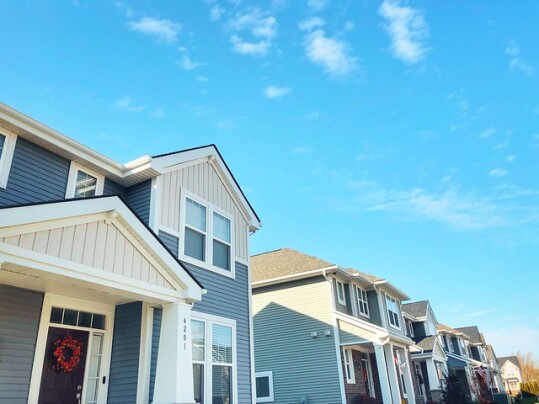Falling temperatures and higher mortgage rates did nothing to slow new home sales in December, according to numbers recently released by the U.S. Census Bureau and the Department of Housing and Urban Development. New home sales defied expectations and rose nearly 12 percent from the month before. The increase pushed sales to their highest level since March and beat economists’ predicted pace by almost 100,000 units. At a time of year when home sales typically slow, the sales surge is an encouraging sign. It’s also evidence that buyer demand remains high, despite a challenging market. Also in the report, the median sales price of new houses sold in December was $377,700, up 3.4 percent from one year ago. The average sales price was $457,300. There were 403,000 new homes for sale at the end of the month. That represents a 6-month supply at the current sales pace. (source)
Archive for January 2022
New Home Sales Beat Expectations In December
Typical Home Sale Generated $94,000 Profit In 2021
Last year was a good year for home sellers. A combination of elevated buyer demand and rising home prices meant homeowners looking to make a move could sell quickly and for a profit. And, according to new numbers from ATTOM Data Solutions, their profit margin in 2021 was the biggest in 13 years. So how big was it? Well, according to the report, the typical home sale last year generated $94,092, representing a 45.3 percent return on investment compared to the original purchase price. That’s up from $64,931 in 2020 and 71 percent higher than it was two years ago, when sellers made $55,000 on their home’s sale. Todd Teta, chief product officer at ATTOM, says 2021 was one the best years ever for home sellers. “What a year 2021 was for home sellers and the housing market all around the U.S.,” Teta said. “Prices went through the roof, kicking profits and profit margins up at a pace not seen for at least a decade … 2021 will go down as one of the greatest years for sellers and one of the toughest for buyers.” (source)
Mortgage Rates Rise For 5th Straight Week
According to the Mortgage Bankers Association’s Weekly Applications Survey, average mortgage rates increased last week from the week before. Rates were up across all loan categories, including 30-year fixed-rate loans with both conforming and jumbo balances, loans backed by the Federal Housing Administration, and 15-year fixed-rate loans. It was the fifth consecutive weekly increase and pushed rates to their highest level since March 2020. Joel Kan, MBA’s associate vice president of economic and industry forecasting, says rising rates have lowered refinance demand. “Unsurprisingly, borrower demand for refinances subsided, with applications falling for the fourth straight week,” Kan said. “After almost two years of lower rates, there are not many borrowers left who have an incentive to refinance.” Purchase activity also fell week over week, though most of the decline was seen among government loan applications. Conventional application demand fell less than one percent. The MBA’s weekly survey has been conducted since 1990 and covers 75 percent of all retail residential mortgage applications. (source)
Affordability Concerns May Lead To Sales Boom
Unless you’re a real estate investor, you probably aren’t making home buying decisions based on market conditions. Most of us decide to buy a house based on what’s happening in our lives. A growing family, a new job, or a desire to move closer to family and friends is more likely to motivate your decision to buy than mortgage rate fluctuations or price increases. However, if you’re thinking about moving sometime soon, conditions can definitely influence how soon. Which is why expectations that mortgage rates will rise this year are raising expectations that home sales may spike this spring. Simply put, home buyers who might have waited till later in the year may bump up their home purchase plans to lock in low rates before they move any higher. But whether or not affordability concerns lead to a sales surge will depend a lot upon spring inventory. Because, while buyers want to get the best deal, they also want to get the best house. And if inventory doesn’t pick up, waiting for better options might outweigh the desire to buy before a potential mortgage rate increase. (source)
Outlook Sees Market Settling Into New Normal
There are few things that haven’t been affected by the pandemic over the past two years. Almost everything about the way we live has changed in one way or the other. That, of course, is especially true of the housing market and economy. The pandemic upset the long-term trends of supply and demand and made it much more difficult to predict where markets might be headed in the weeks and months ahead. But now that we’re two years into it, the pandemic and its effects are a little more predictable and, according to the latest forecast from Fannie Mae’s Economic and Strategic Research Group, it may mean we’re beginning to settle into a new normal. “The ESR Group expects inflation to remain elevated in 2022, while still unknown is the extent to which structural shifts in the economy and housing market over the past two years become permanent,” the forecast reads. “However, the ESR Group foresees economic growth returning to more modest levels consistent with the long-run trend, while home sales and house price growth slow to a more sustainable pace.” In other words, while things are still somewhat unpredictable, there’s a growing expectation that the volatility of the past two years may finally be coming to an end. (source)
Work Uncertainty May Be Holding Buyers Back
Work is a fact of life. It’s how we pay the bills. It’s also a big part of how we choose where we live. After all, nobody wants to spend three hours a day driving to and from the office. So the closer we can live to our workplace the better. But while a short commute has always ranked high on home buyer wish lists, the pandemic has changed that. More Americans are able to work remotely and it’s given them more freedom to choose where they live. A lot of us, though, are still waiting to hear what our long-term work arrangements will be. In fact, according to a recent survey, just 52 percent of workers say their employer has announced post-pandemic arrangements. That means, many of us are in limbo. And naturally, that effects home buying plans. For example, the same survey found the number of respondents who said they were considering a move in the next three years was greater among those who knew their long-term work arrangements than those still waiting to hear. That means, there are a lot of potential home buyers on the sidelines until their employer lays out post-pandemic plans. As those plans are announced, they’ll have a big impact on the housing market, as it’ll determine who’s buying and where they’re looking to move. (source)
Annual Home Sales Hit Highest Level Since 2006
In 2021, sales of previously owned homes hit their highest level in 15 years, according to new numbers from the National Association of Realtors. Existing-home sales totaled 6.12 million, increasing 8.5 percent from the year before. But while sales were strong throughout the year, they slowed in December, as the number of available listings fell. Lawrence Yun, NAR’s chief economist, says, despite the end-of-year slowdown, demand from buyers remains high. “December saw sales retreat, but the pull back was more a sign of supply constraints than an indication of a weakened demand for housing,” Yun said. “We saw inventory numbers hit an all-time low in December. Home builders have already made strides in 2022 to increase supply, but reversing gaps like the ones we’ve seen recently will take years to correct.” Despite the continuing supply issues, Yun says home-price increases will slow significantly this year, rising between three and five percent rather than the double-digit increases seen last year. (source)







